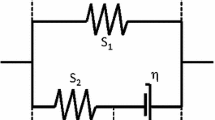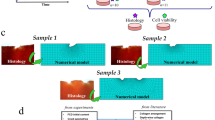Abstract
The streaming potential response of cartilage in the confined compression creep configuration was assessed theoretically and measured experimentally in normal and proteoglycan-depleted tissue. The analytical solution, using the linear biphasic continuum model including electrokinetics and assuming homogeneous material properties, predicted that: (i) the peak streaming potentials is ΔV=ke·Δσ, where ke is the electrokinetic coefficient and Δσ is the change in compressive stress; (ii) the potential is maintained at 95 to 100% of the peak value of 0<t<0.10τ, where τ is the gel diffusion time constant; and (iii) during short times, 0<t<0.01 τ, 90% of the peak streaming potential occurs over a region extending 23% into the tissue sample. Experimentally, adult bovine cartilage disks, 0.5 mm thick, were subjected to step changes of compressive stress. The measured changes in potential indicated a linear response for changes in stress up to 0.10 MPa. The ke of normal cartilage, estimated from the short time (0<t<2 sec) change in potential, was −1.65±1.25 mV/MPa. Digestion of cartilage by chondroitinase ABC resulted in an increased (less negative) ke of −0.75±0.70 mV/MPa and a 33±29% depletion of anionic glycosaminoglycan, whereas digestion with trypsin resulted in a further increase in ke to +1.64±0.95 mV/MPa and a 98±1% depletion of glycosaminoglycan. The streaming potential measurement may be a useful addition to the widely used confined compression creep test to assess cartilage material properties.
Similar content being viewed by others
Abbreviations
- δ:
-
specimen thickness
- ke :
-
electrokientic coefficient
- kij :
-
electrokinetic coupling coefficients (i,j=1,2)
- kp :
-
open circuit hydraulic permeability
- HA :
-
equilibrium confined compression modulus
- J:
-
current density
- Pf :
-
fluid pressure
- s:
-
sample standard deviation
- σo, Δσ:
-
applied compressive stress, change in applied compressive stress
- t, ť:
-
time, normalized time
- tp :
-
duration of a pulse in stress
- τ:
-
gel diffusion time
- u, û:
-
displacement, normalized displacement
- U:
-
fluid velocity relative to solid phase
- \(V,\hat V\) :
-
electrical potential, normalized potential
- \(\Delta V,\hat V_{OC} \) :
-
open circuit streaming potential, normalized streaming potential
- z, ž:
-
position relative to the articular surface, normalized position
References
Armstrong, C. G., and V. C. Mow. Variations in the intrinsic mechanical properties of human articular cartilage with age, degeneration, and water content.J. Bone Joint Surg. 64A:88–94, 1982.
Bassett, C. A. L., and R. J. Pawluk. Electrical behavior of cartilage during loading.Science 178:982–983, 1972.
Berkenblit, S. I., E. H. Frank, E. P. Salant, and A. J. Grodzinsky. Nondestructive detection of cartilage degeneration using electromechanical surface spectroscopy.J. Biomech. Eng. 116:384–392, 1994.
Bonassar, L. J., E. H. Frank, J. Murray, C. G. Paguio, V. L. Moore, M. W. Lark, and A. J. Grodzinsky. Changes in cartilage composition and functional properties due to stromelysin degradation.Trans. Orthop. Res. Soc. 18:192, 1993.
Bonassar, L. J., C. G. Paguio, E. H. Frank, K. A. Jeffries, V. L. Moore, M. W. Lark, and A. J. Grodzinsky. Effects of matrix metalloproteinases on cartilage swelling and biophysical propertiesin vitro andin vivo.Trans. Orthop. Res. Soc. 19:310, 1994.
Buschmann, M. D., J. S. Jurvelin, and E. B. Hunziker. Comparison of sinusoidal and stress relaxation measurements of cartilage in confined compression: the biphasic poroelastic model and the role of the porous compressing platen.Trans. Orthop. Res. Soc. 20:521, 1995.
Chen, A. C., T. T. Nguyen, and R. L. Sah. Streaming potentials in normal and degraded articular cartilage.Trans. Orthop. Res. Soc. 20:336, 1995.
DeGroot, S. R., and P. Mazur. Nonequilibrium Thermodynamics, Amsterdam, North-Holland Publishing Company 1969, pp. 1–510.
Eisenberg, S. R., and A. J. Grodzinsky. Electrokinetic micromodel of extracellular matrix and other polyelectrolyte networks.Physicochem. Hydrodyn. 10:517–539, 1988.
Farndale, R. W., D. J. Buttle, and A. J. Barrett. Improved quantitation and discrimination of sulphated glycosaminoglycans by use of dimethylmethylene blue.Biochim. Biophys. Acta 883:173–177, 1986.
Frank, E. H., and A. J. Grodzinsky. Cartilage electromechanics. I. Electrokinetic transduction and the effects of electrolyte pH and ionic strength.J. Biomech. 20:615–627, 1987.
Frank, E. H., and A. J. Grodzinsky. Cartilage electromechanics. II. A continuum model of cartilage electrokinetics and correlation with experiemnts.J. Biomech. 20:629–639, 1987.
Frank, E. H., A. J. Grodzinsky, T. J. Koob, and D. R. Eyre. Streaming potentials: a sensitive index of enzymatic degradation in articular cartilage.J. Orthop. Res. 5:497–508, 1987.
Frank, E. H., A. J. Grodzinsky, S. L. Phillips, and P. E. Grimshaw. Physicochemical and bioelectrical determinants of cartilage material properties. In: Biomechanics of diarthrodial joints, edited by V. C. Mow, A. Ratcliffe, and S. L. Y. Woo. New York: Springer-Verlag, 1990, pp. 261–282.
Geddes, L. A., and L. E. Baker. Principles of Applied Biomedical Instrumentation. New York: John Wiley & Sons, 1989, pp. 1–961.
Gray, M. L., A. M. Pizzanelli, A. J. Grodzinsky, and R. C. Lee. Mechanical and physicochemical determinants of the chondrocyte biosynthetic response.J. Orthop. Res. 6:777–792, 1988.
Grimshaw, P. E. The response of cartilage in compression as it undergoes diffusion limited chemical changes. MS Thesis (electrical engineering). Camgridge, MA: Massachusetts Institute of Technology, 1982.
Grodzinsky, A. J.. Electromechanical and physiocochemical properties of connective tissue.CRC Crit. Rev. Bioeng. 9:133–199, 1983.
Grodzinsky, A. J., and E. H. Frank. Electromechanical and physicochemical regulation of cartilage strength and metabolism. In: Connective tissue matrix, vol. II. Topics in molecular and structural biology, edited by D. W. L. Hukins, Boca Raton, FL: CRC Press, 1990, pp. 91–126.
Grodzinsky, A. J., H. Lipshitz, and M. J. Glimcher. Electromechanical properties of articular cartilage during compression and stress-relaxation.Nature 275:448–450, 1978.
Gu, W. Y., W. M. Lai, and V. C. Mow. Transport of fluid and ions through a porous-permeable charged-hydrated tissue, and streaming potential data on normal bovine articular cartilage.J. Biomech. 26:709–723, 1993.
Helfferich, F. Ion Exchange. New York: McGraw-Hill, 1962, pp. 1–624.
Kim, Y. J., L. J. Bonassar, and A. J. Grodzinsky. The role of cartilage streaming potential, fluid flow and pressure in the stimulation of chondrocyte biosynthesis during dynamic compression.J. Biomech. 28:1055–1066, 1995.
Lai, W. M., J. S. Hou, and V. C. Mow. A triphasic theory for the swelling and deformation behaviors of articular cartilage.J. Biomech. Eng. 113:245–258, 1991.
Lee, R. C., E. H. Frank, A. J. Grodzinsky, and D. K. Roylance. Oscillatory compressional behavior of articular cartilage and its associated electromechanical properties.J. Biomech. Eng. 103:280–292, 1981.
Lotke, P. A., J. Black, and S. J. Richardson. Electromechanical properties in human articular cartilage.J. Bone Joint Surg. 56A:1040–1046, 1974.
Maroudas, A. Physicochemical properties of cartilage in the light of ion exchange theory.Biophys. J. 8:575–595, 1968.
Maroudas, A. Physico-chemical properties of articular cartilage. In: Adult articular cartilage, edited by M.A.R. Freeman. Tunbridge Wells, England: Pitman, 1979, pp. 215–290.
Maroudas, A., and P. Bullough. Permeability of articular cartilage.Nature 219:1260–1261, 1968.
Maroudas, A., H. Muir, and J. Wingham. The correlation of fixed negative charge with glycosaminoglycan content of human articular cartilage.Biochim. Biophys. Acta 177:492–500, 1969.
Mow, V. C., S. C. Kuei, W. M. Lai, and C. G. Armstrong. Biphasic creep and stress relaxation of articular cartilage in compression: theory and experiment.J. Biomech. Eng. 102:73–84, 1980.
Mow, V. C., W. Zhu, and A. Ratcliffe. Structure and function of articular cartilage and meniscus. In: Basic orthopaedic biomechanics, edited by V. C. Mow and W. C. Hayes, New York, Raven Press, 1991, pp. 143–198.
O'Connor, P., C. R. Orford, and D. L. Gardner. Differential response to compressive loads of zones of canine hyaline articular cartilage: micromechanical light and electron microscopic studies.Ann. Rheum. Dis. 47:414–420, 1988.
Reindel, E. S., A. M. Ayroso, A. C. Chen, R. M. Schinagl, D. M. Chun, and R. L. Sah. Integrative repair of articular cartilagein vitro: adhesive strength of the interface region.J. Orthop. Res. 13:751–760, 1995.
Sah, R. L., S. B. Trippel, and A. J. Grodzinsky. Differential effects of serum, IGF-I, and FGF-2 on the maintenance of cartilage physical properties during long-term culture.J. Orthop. Res. 14:44–52, 1996.
Sandy, J. D., A. H. K. Plaas, and L. Rosenberg. Structure, function and metabolism of cartilage proteoglycans. In: Arthritis and allied conditions, edited by D. J. McCarty, and W. J. Koopman. Baltimore. Williams and Wilkins, 1997, pp. 229–242.
Schinagl, R. M., M. K. Ting, J. H. Price, and R. L. Sah. Video microscopy to quantitate the inhomogeneous confined compression modulus of articular cartilage.Ann. Biomed. Eng. 24:500–512, 1996.
Schneiderman, R., D. Kevet, and A. Maroudas. Effects of mechanical and osmotic pressure on the rate of glycosaminoglycan synthesis in the human adult femoral head cartilage: an in vitro study.J. Orthop. Res. 4:393–408, 1986.
Thurston, C. F., T. E. Hardingham, and H. Muir. The kinetics of degradation of chondroitin sulphate and hyaluronic acid by chondroitinase from proteus vulgaris.Biochem. J. 145:397–400, 1975.
Author information
Authors and Affiliations
Rights and permissions
About this article
Cite this article
Chen, A.C., Nguyen, T.T. & Sah, R.L. Streaming potentials during the confined compression creep test of normal and proteoglycan-depleted cartilage. Ann Biomed Eng 25, 269–277 (1997). https://doi.org/10.1007/BF02648041
Received:
Revised:
Accepted:
Issue Date:
DOI: https://doi.org/10.1007/BF02648041




